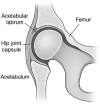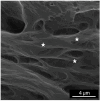Immunohistochemical and Ultrastructural Study of the Degenerative Processes of the Hip Joint Capsule and Acetabular Labrum
- PMID: 40804896
- PMCID: PMC12345908
- DOI: 10.3390/diagnostics15151932
Immunohistochemical and Ultrastructural Study of the Degenerative Processes of the Hip Joint Capsule and Acetabular Labrum
Abstract
Background/Objectives: Degenerative processes of the hip joint increasingly affect not only the articular cartilage but also periarticular structures such as the joint capsule and acetabular labrum. This study aimed to investigate the structural and molecular changes occurring in these tissues during advanced hip osteoarthritis. Methods: A combined analysis using immunohistochemistry (IHC), scanning electron microscopy (SEM), and micro-computed tomography (microCT) was conducted on tissue samples from patients undergoing total hip arthroplasty and from controls with morphologically normal joints. Markers associated with proliferation (Ki67), inflammation (CD68), angiogenesis (CD31, ERG), chondrogenesis (SOX9), and lubrication (Lubricin) were evaluated. Results: The pathological group showed increased expression of Ki67, CD68, CD31, ERG, and SOX9, with a notable decrease in Lubricin. SEM analysis revealed ultrastructural disorganization, collagen fragmentation, and neovascular remodeling in degenerative samples. A significant correlation between structural damage and molecular expression was identified. Conclusions: These results suggest that joint capsule and acetabular labrum degeneration are interconnected and reflect a broader pathophysiological continuum, supporting the use of integrated IHC and SEM profiling for early detection and targeted intervention in hip joint disease.
Keywords: CD68; ERG; SEM; SOX9; acetabular labrum; hip capsule; immunohistochemistry; joint degeneration; lubricin; osteoarthritis.
Conflict of interest statement
The authors declare no conflicts of interest.
Figures


















References
-
- Toma A.G., Salahoru P., Hinganu M.V., Hinganu D., Cozma L.C.D., Patrascu A., Grigorescu C. Reducing the Duration and Improving Hospitalisation Time by Using New Surgical Tehniques and Psychotherapy. Rev. Chim. 2019;70:143–146. doi: 10.37358/RC.19.1.6869. - DOI
-
- Nakajima A., Sakai R., Inoue E., Harigai M. Prevalence of patients with rheumatoid arthritis and age-stratified trends in clinical characteristics and treatment, based on the National Database of Health Insurance Claims and Specific Health Checkups of Japan. Int. J. Rheum. Dis. 2020;23:1676–1684. doi: 10.1111/1756-185X.13974. - DOI - PubMed
LinkOut - more resources
Full Text Sources
Research Materials

